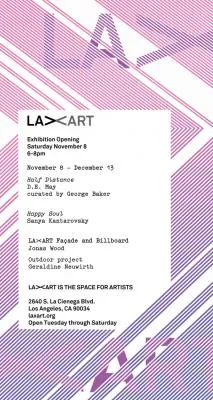
D.E. May
"Half Distance"
Curated by George Baker
November 8, 2014 - December 20, 2014
Opening Reception
Saturday, November 8, 6-8pm.
LAXART
2640 S. La Cienega Blvd.
Los Angeles, CA 90034
D.E. May (b. 1952) is an Oregon-based artist active since the early 1970s, whose work emerged in relation to the under-known history of modernist experiment in the Pacific Northwest. He is a crucial figure in that regional context, but is also relatively unknown beyond it. This is the largest exhibition of D.E. May’s work outside of Oregon to date, and the first introduction of this major artist’s work to Los Angeles and the Southern California region.
Over a forty-year career, May has worked to extend and intensify a range of avant-garde languages, inventing a particular form of abstraction created from the re-use of materials found in the urban environment. Residing in Salem, Oregon, the artist exceeds any regional frame to engage directly the history of key abstract strategies such as constructivism, geometric abstraction, and the monochrome. But the work also explores the readymade and collage practice typical of Dada, or the child-like scale and alternative distribution channels (such as mail art) later explored by Fluxus, as well as the textual, archival, and architectural tactics central to certain forms of Conceptual art. Indeed, the work seems to evoke the ghosts of an eclectic but very specific range of canonical modernist or postwar artists, embraced in all their incompatibility and evident contradiction with each other: Kurt Schwitters and Kasimir Malevich; Joseph Cornell and Joseph Beuys; the precarious grids of painter Agnes Martin and the aggressive geometric cut-outs of Gordon Matta-Clark; the notion of a spontaneous Art Brut elaborated by Jean Dubuffet and the street aesthetics of the early work of Claes Oldenburg.
And yet the art of D.E. May also references everyday objects, simple and useful things, like tools, architectural shelters, or maps. With its titles and general spirit, the work often evokes the outdated places and characters found in film noir movies, or albums and song titles from our vinyl-record past. Allegorical references to mysterious regions or lands abound, utopian zones perhaps, or long-ago sites that have passed into oblivion. In their construction, May’s objects also echo the labors characteristic of a range of non-art occupations like dressmaking or furniture design or haphazard carpentry.
Typically small if not miniature in scale, often no larger than an index card or even a postage stamp, May’s work is usually pieced together from weathered cardboard and paper scraps, found material altered in almost imperceptible ways. While meticulously handcrafted, the work usually appears anonymous, as if created by impersonal forces of the natural world such as erosion, staining, or over-exposure to the sun. The work bases itself in processes of salvage and reuse, recycling the discarded materials of the artist’s home environment into an infinitely variegated language of abstract form.
Organized as a miniature retrospective--the artist was last the subject of a mid-career retrospective in 2003 in Portland--the exhibition at LAXART includes a range of key early works of the 1980s and 1990s shown alongside series completed more recently. Some of D.E. May’s earliest salvaged cardboard constructions are present, acting as historical anchors and archival reminders of the aesthetic development that has led to the recent work. Ranging from gentle grids to organic found materials to precarious architectural models cobbled-together from detritus, the exhibition comprises both small and larger-scale works that often hover characteristically, and ambivalently, halfway between complete abstraction and recognizable objects in and from the world.
The exhibition features a recent series of gridded works on paper entitled Template Studies, shown for the first time in the 2014 Portland Biennial (organized by former LAXART curator Amanda Hunt). The Template Studies are accompanied here by several older series of cutout cardboards simply entitled Templates, like a set of potential stencils that could be used to produce further abstract forms. A new body of work comprising twenty-four miniature layered abstractions, from an on-going series entitled Testbeds--salvaged materials inlaid upon or incised from other found materials--has been produced especially for the LAXART exhibition. It co-exists in the space with a series of older artist books, miniature constructions, sculpture, ephemera, and rarely- or never-exhibited work borrowed from major private collections in Oregon, Los Angeles, and New York.
The exhibition is guest-curated by George Baker, an art critic, editor, and art historian based at the University of California, Los Angeles. Three years ago, Baker visited Oregon under the auspices of a new program initiated by the Ford Family Foundation, involving a series of studio visits with artists across the state. Baker’s encounter with D.E. May was the starting point of a dialog and correspondence that has culminated in the current exhibition of work--the product of a set of interests and passions shared between the artist and the art historian.
About the Artist
D.E. May has been the subject of a mid-career retrospective entitled “D.E. May: The Occupations” at Marylhurst University near Portland in 2003, and the solo museum exhibition “The Artist as Archivist” at the Hallie Ford Museum of Art, Willamette University in 2008. Recently, May was included in the 2014 Portland Biennial, and was a recipient of 2013 Hallie Ford Fellowship in the Visual Arts from the Ford Family Foundation. May is represented in Portland by PDX Contemporary Art.
About LAXART
Founded in 2005, LAXART is Los Angeles’ leading independent contemporary art space supporting and presenting experimental exhibitions, public art initiatives, and publications with emerging, mid-career and established local, national and international artists.
Works by D.E. May:
http://www.pdxcontemporaryart.com/may